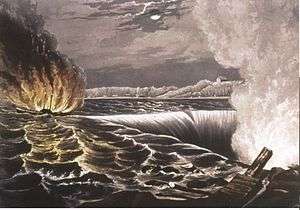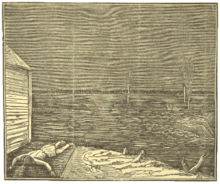Caroline affair
The Caroline affair (also known as the Caroline case) was a diplomatic crisis beginning in 1837 involving the United States, Britain, and the Canadian independence movement. It began in 1837 when William Lyon Mackenzie and other Canadian rebels, with support from US citizens, fled to an island in the Niagara River, in the ship Caroline. British forces crossed the Niagara River, to board and capture the vessel where it was moored, at Schlosser's Landing, in US territory. Shots were exchanged and one US citizen, a watchkeeper, was killed. British forces set fire to the Caroline and set it adrift in the Niagara River, about two miles above Niagara Falls. Sensationalized accounts of the affair were published by contemporary newspapers.

The British action outraged civilians on both sides of the US–Canadian border. In retaliation, a private militia composed of both US citizens and Canadians attacked a British vessel and destroyed it. During 1838, there were several other clashes pitting British forces against private militia. The diplomatic crisis was defused by the negotiations that led to the Webster-Ashburton Treaty in 1842, in which both the US and British admitted to wrongdoing.
In the aftermath, the incident led to the legal principle of the "Caroline test". The principle states that the necessity for [self-defense] must be "instant, overwhelming, and leaving no choice of means, and no moment for deliberation", as formulated by Daniel Webster in his response to British claims that they attacked the Caroline in self-defense. According to scholars, the "Caroline test" remains an accepted part of international law today. For example, Tom Nichols (2008) has stated:
Thus the destruction of an insignificant ship in what one scholar has called a "comic opera affair" in the early 19th century nonetheless led to the establishment of a principle of international life that would govern, at least in theory, the use of force for over 250 years.[1]
Background
The Reform Movement of Upper Canada (today's Ontario) was a movement to make the British colonial rule in Canada more democratic and less corrupt. William Lyon Mackenzie was one of the key leaders of this movement. He was repeatedly elected to serve in a hostile parliament that repeatedly ejected him for his reform efforts. By 1837, Mackenzie had given up on peaceful means for reform and began to prepare for an uprising.
In December 1837, Mackenzie began the Upper Canada Rebellion by fighting the British in the Battle of Montgomery's Tavern. Mackenzie's forces were seriously outnumbered and outgunned, and they were defeated in less than an hour. He also suffered another major defeat a few days later in London. After these defeats, Mackenzie fled to Navy Island in the Niagara River, which they declared the Republic of Canada, on board the vessel SS Caroline.
Throughout these events, the Canadian rebels enjoyed widespread support from the Americans, who provided them supplies and bases from which to launch raids on the British.
Events


On December 29, 1837, while the Canadian rebels were on Navy Island, Canadian loyalist Colonel Sir Allan MacNab and Captain Andrew Drew of the Royal Navy commanding a party of militia, acting on information and guidance from Alexander McLeod that the vessel belonged to Mackenzie, crossed the international boundary and seized the Caroline, chased off the crew, towed her into the current, set her afire, and cast her adrift over Niagara Falls, after killing one black American named Amos Durfee in the process. His body was later exhibited in front of a recruiting tavern in Buffalo, New York.
Minister H. S. Fox, in an 1841 letter to John Forsyth, summarized the British justification for the incursion:
The steamboat Caroline was a hostile vessel engaged in piratical war against her Majesty's people...it was under such circumstances, which it is to be hoped will never recur, that the vessel was attacked by a party of her Majesty's people, captured and destroyed.[2]
New York's response:
Those of our fellow citizens...single-handed and alone, left our territory and united themselves with a foreign power, have violated no law...they have done no more than has been done again and again by the people of every nation. Your own recollections of history will furnish your minds with hundreds of examples. The Swiss nation have, for hundreds of years, fed all the armies of Europe; and who ever thought of holding them responsible for it? They did no more than Admiral Lord Cochrane did in taking part with South America. They did no more than Lord Byron did, who gave his life to aid the Greeks in breaking the chains of Turkish bondage. They did no more than Lafayette. Gentlemen, I am not deviating from the case further than is necessary to remove the just odium which has been unjustly thrown upon those who joined the insurgents.
US newspapers falsely reported "the death of twenty-two of her crew" when in fact, only Durfee was killed. Public opinion across the United States was outraged against the British. President Martin Van Buren protested strongly to London, but was ignored.
On May 29, 1838, 13 raiders, mostly Canadian and American refugees from the 1837 rebellion, led by American William "Pirate Bill" Johnston,[3] retaliated by capturing, looting, and burning the British steamer Sir Robert Peel while she was in U.S. waters. President Martin Van Buren sent General Winfield Scott to prevent further incursions into Canada.[4] However, there were several other attacks, the biggest being the Battle of the Windmill in November 1838.
Later that year, Irish-Canadian rebel Benjamin Lett murdered a loyalist, Captain Edgeworth Ussher, who had been involved in the Caroline affair.
The case was finally disposed of by U.S. Secretary of State Daniel Webster and Alexander Baring, 1st Baron Ashburton, in the course of their negotiations leading to the Webster–Ashburton Treaty of 1842. Secretary Webster admitted that the employment of force might have been justified by the necessity of self-defence, but denied that such necessity existed, while Lord Ashburton, although he maintained that the circumstances afforded excuse for what was done, apologized for the invasion of United States territory.[5]
Aftermath
Shortly after the incident, a Canadian sheriff named Alexander McLeod claimed that he had helped attack the Caroline during the Caroline affair. McLeod was arrested in the United States in 1840 for his role in Durfee's death during the attack. This caused yet another international incident, as the British demanded his release, stating that he should not be held criminally responsible for following orders. The trial attempted to identify who exactly had shot Durfee, but this proved futile. McLeod was acquitted of all charges as witness statements made it clear that he had no involvement in the incident.
Anticipatory self-defense
This incident has been used to establish the principle of "anticipatory self-defense" in international politics, which holds that it may be justified only in cases in which the "necessity of that self-defense is instant, overwhelming, and leaving no choice of means, and no moment for deliberation". This formulation is part of the Caroline test. The Caroline affair is also now invoked frequently in the course of the dispute around preemptive strike (or preemption doctrine).[6]
See also
- Timeline of United States diplomatic history
- Aroostook War, militias mobilized but no battles
References
- Nichols, Thomas (2008). The Coming Age of Preventive War. University of Pennsylvania Press. p. 2. ISBN 978-0-8122-4066-5
- Hartford Times, "Mr Fox to Mr. Forsyth", January 9, 1841
- Searching for a Pirate's Lost Lair. By Shaun J. McLaughlin. Thousand Islands Magazine, February 13, 2012.
- Chapter 7, "British Steamer is Burned by Patriots" in Northern New York In The Patriot War, 1923, By L. N. Fuller
- Moore, John Bassett (1906). A Digest of International Law. Volume 2. Government Printing Office. pp. 25, 409 & 410. Retrieved 2009-11-11.
- Greenwood, Christopher. The Caroline, Max Planck Encyclopedia of Public International Law
Further reading
- Howard Jones; To the Webster-Ashburton Treaty: A Study in Anglo-American Relations, 1783-1843 University of North Carolina Press, 1977
- Kenneth R. Stevens; Border Diplomacy- The Caroline and McLeod Affairs in Anglo-American-Canadian Relations, 1837-1842 University of Alabama Press, 1989; ISBN 0-8173-0434-7
- Wiltse, Charles M. "Daniel Webster and the British Experience." Proceedings of the Massachusetts Historical Society Vol. 85. (1973) pp 55-87 online.